

WASH and Women. Mpcb.gov.in/images/pdf/draft-bmwmh.pdf. Sanitary napkin disposal bag from SWaCH — Welcome to the eCoexist network! PMC starts sanitary pad disposal centre. To dispose of sanitary napkins in a hygienic manner, the Pune Municipal Corporation (PMC) with the help of city-based NGO Jan Adhar has started a Sanitary Napkins Disposal Project under which 800 napkins can be disposed of per day.

PMC claims to be the first municipal corporation in the country to start such a project. Presently, sanitary napkins are not segregated from other solid wastes and are disposed of along with other garbage at the garbage depot in Undri. The new centre has been set up at Vartak garden in Shaniwar Peth on an experimental basis for ward number 37. The centre will be inaugurated by member of assembly Madhuri Misal on Saturday. Mukta Tilak, Bharatiya Janata Party (BJP) corporator of ward number 37, said, “The present population of the city is 40 lakh.
Sanitary napkins clogging city. Almost every one might have come across signboards in restrooms in public places or toilets in public transport system, instructing women not to dispose of used sanitary napkins in toilets.
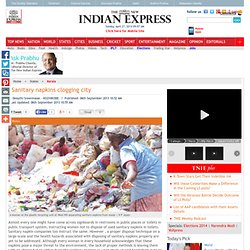
Sanitary napkin companies too instruct the same. However , a proper disposal technique on a large-scale and the health hazards associated with disposing of sanitary napkins properly are yet to be addressed. Although every woman in every household acknowledges that these napkins pose a major threat to the environment, the lack of proper methods is leaving them with no choice but to either burn the sanitary napkins or wrap them up and hand them over to waste collectors. An uncomfortable but scary truth. Www.nif.org.in/bd/upload/innovator_profile_pdf/a.muruganantham.pdf.
Sanitary napkins with bamboo pulp score over regular pads. ShareThis Facebook Tweet Email In a first-of-its-kind venture in India, bamboo pulp is being used in the manufacture of sanitary pads as absorbing material, instead of the regular wood pulp.

Bamboo pulp has advantages: one, it is 300 per cent more absorbent and safer than wood pulp; two, it economises on the use of wood; and three, compost can be made out of it. Eco Femme. New Indian Express Express, 15 December 2013 You may brush off Kathy Walkling’s suggestion of using a cloth pad instantly.
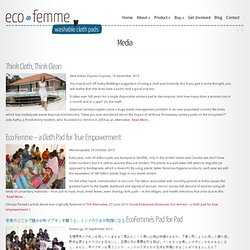
But if you give it some thought, you will realise that she does have a point. Menstrual Cup: time to reduce that monthly plastic. We don’t have statistics from India, but one can safely assume that the phenomenon is similar everywhere.
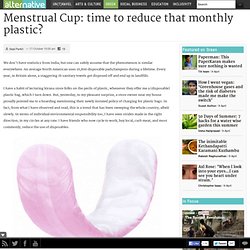
An average North American uses 16,800 disposable pads/tampons during a lifetime. Every year, in Britain alone, a staggering 1b sanitary towels get disposed off and end up in landfills. I have a habit of lecturing kirana store folks on the perils of plastic, whenever they offer me a (disposable) plastic bag, which I turn down. But, yesterday, to my pleasant surprise, a store owner near my house proudly pointed me to a hoarding mentioning their newly instated policy of charging for plastic bags.
In fact, from what I have observed and read, this is a trend that has been sweeping the whole country, albeit slowly. However, this post revolves around one disposable item that most of us think is impossible to avoid – disposable sanitary pads, the very discussion of which makes many of us squeamish. AID Publications - No Need to Whisper - Jivika Proudly Presents Cloth Sanitary Napkins. Disposable sanitary napkin manufacturers market not only a product, but an attitude - that we can feel confident, go out and about, not worry about our period.
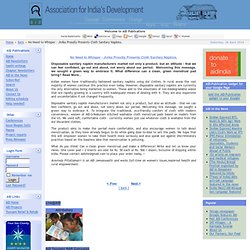
Welcoming this message, we sought a green way to embrace it. What difference can a clean, green menstrual pad bring? Read More... Alternatives emerge for disposable diapers and sanitary napkins. There is one category of waste few want to discuss: used sanitary napkins and disposable diapers.
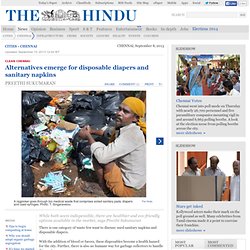
With the addition of blood or faeces, these disposables become a health hazard for the city. Further, there is also no humane way for garbage collectors to handle this waste. The environmental trail of these disposables is even more alarming. A parent choosing disposable diapers, typically till the baby is two years old, would run through 5,000 disposable diapers which would require 20 trees to be cut down and 1,180 litres of crude oil burnt during manufacture.
The statistics around feminine hygiene products are no less alarming. Www.johnson.cornell.edu/Portals/0/PDFs/1st place.pdf. Now get a sanitary napkin for Rs 2.50. A teacher-student duo of the Institute of Technology and Management (ITM) here has designed a machine that will be able to provide a biodegradable sanitary napkin for just Rs.2.50 apiece.

Assistant professor Ashwini Sharma, along with his pupil Surbhit Arora, used wood pulp to produce the napkin, which is both biodegradable and cost-effective. ‘A majority of the rural and poor urban women in India use pieces of cloth and other unhygienic things during menstruation, as they cannot buy sanitary napkins which are expensive. We hope the machine will be helpful to them,’ said Sharma. The machine can make the napkin in a three-step process that involves pressing, sealing and cutting. The Water Hyacinth Sanitary Pad Project. An Abundant Source Solution Addressing a Barrier to Girls Education while Tackling an Environmental Crisis The Water Hyacinth Sanitary Pad Project is a sustainable social enterprise that produces biodegradable sanitary pads out of water hyacinth, an invasive aquatic species, as well as other local agricultural waste.
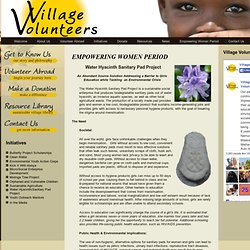
The production of a locally made pad provides girls and women a low cost, biodegradable product that sustains income-generating jobs and provides girls with access to necessary personal hygiene products, with the goal of breaking the stigma around menstruation. The Need Societal: All over the world, girls face unthinkable challenges when they begin menstruation. Without access to hygiene products girls can miss up to 50 days of school per year, causing them to fall behind in class and be ill-prepared for national exams that would have given them a chance to receive an education. Shelving his studies to make sanitary pads. It was his final year at the Nanyang Technological University and his peers were busy preparing for the final exams or job hunting.
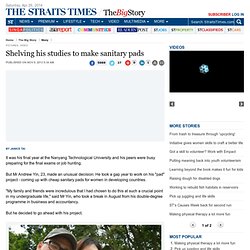
But Mr Andrew Yin, 23, made an unusual decision: He took a gap year to work on his "pad" project - coming up with cheap sanitary pads for women in developing countries. "My family and friends were incredulous that I had chosen to do this at such a crucial point in my undergraduate life," said Mr Yin, who took a break in August from his double-degree programme in business and accountancy. But he decided to go ahead with his project. Mr Andrew Yin and Ms Ho Yen Yee with the sanitary pad prototype they came up with using corn leaf and water hyacinth fibres (in the container). -- ST PHOTO: KUA CHEE SIONG Undergraduate Mr Andrew Yin, 23, took a gap year just to work on his “pad” project - coming up with cheap sanitary pads for women in developing countries. "The time was right and opportunities don't wait for us to be ready, you just have to seize them," he said.
Anandi.